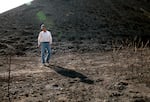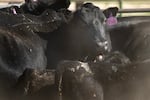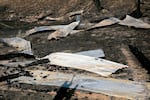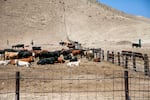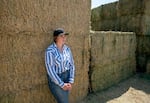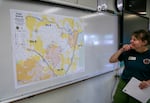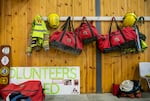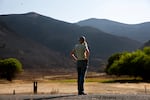
Amanda Smull looks at burned land neighboring her family's grazing lands near Durkee, Ore., July 31, 2024. "This is the first time I've been out here since it burned," she says. "It's hard to see."
Anna Lueck / OPB
BAKER CITY, Ore. — In a normal year, the grass is mostly dry in the summer. The mountains look yellow with some spots of green, lots of sagebrush and some short trees bunched together.
Standing in her front yard, Amanda Smull points to hills where the lightning hit and sparked a fire on July 17.
“You can see [fire] retardant lines on the hill over there,” she says. “The fire was so hot and fast that it just blew through those retardant lines. There really was nothing that they could do.”
Just over a week after the fire, she and her husband, Jared, a fifth generation rancher, hop on their truck and start driving up a winding dirt road that loops around the Rye Valley — roughly 20 miles west of Baker City.
Amanda, who hadn’t been up the range grounds since the fire blazed through, looks towards the sagebrush and the junipers. They’re scorched and the mountains are black.
“There’s just not a blade of grass left out there,” she says.

Jared Smull points out burned land at the beginning of the drive into Rye Valley, where he and his family grazed their cattle for many years before the Durkee fire, July 31, 2024. The Smull family lost about 15 cows and thousands of acres of grazeable land in the fire.
Anna Lueck / OPB
The fire has displaced and killed a still unaccounted number of cattle. The Smulls lost at least five cows and nine calves, some are still missing on the range. There’s also a handful they’ve managed to put in a corral, they’re too badly injured and will likely end up in a sale yard.
This couple’s challenges are reflected on ranches across Eastern Oregon. Where cattle have survived, some ranchers will have to spend more to keep their cattle fed or sell some of their cows — because there’s nowhere to put them. As the fires smolder, many ranchers have been left figuring out what to do next, as they face devastation to public and private lands that most have never seen before, at least in recent memory.
Uncertainty and tough decisions
The Smulls graze some 200 head of cattle on private and federal lands they lease in the valley, usually from early spring until fall. But those rangelands have burned bare, so their cows and calves are back home on the meadows — where they normally spend the winter months.
Strong winds and lots of dry grass carried the Durkee Fire through nearly 295,000 acres of range in Baker and Malheur counties — making it one of the largest wildfires in Oregon so far this season. That fire eventually merged with the Cow Valley Fire, which had burned some 133,000 acres a few days prior.
Jared Smull, who grew up in Eastern Oregon, says they’re used to some fire, but nothing like this.
“This scale, we’ve never seen around here. It’s nuts,” he says.
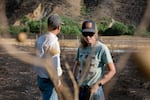
Jared Smull, left, and his wife Amanda stand on burned land at the edge of their rangeland near Durkee, Ore., July 31, 2024. Jared, a fifth generation rancher, says he has never experienced a burn of this scale. He anticipates it will take several years to recover.
Anna Lueck / OPB
But there’s another problem. The fires have burned a combination of private and federal lands, burning miles of wooden fencing, and scorching the grass their cattle and other wildlife eat. That has left many ranchers figuring out how to find enough feed, including the Smulls.
“I mean you can just look around,” Amanda Smull says. “There’s nothing left and we don’t even know what next spring will look like. It probably depends on the severity of the burns.”
Buying feed while the pasture recovers might not be sustainable, and it’s not just buying hay for the summer. Jared Smull figures in the winter months alone he’ll go through 400 tons of hay to feed his cows, which could cost as much as $60,000.
“Can you afford two years of losses before your banker says, ‘No, you’re done, you’re selling your cows and getting flush’? And then you don’t have anything and it takes a long time to rebuild,” Jared says.
Amanda adds they will likely receive compensation from insurance, but it won’t replace what they’ve lost.
“It’s not like having your barn or house burned down and then getting money to rebuild a house,” she says. “It is just different, in that you can’t replace those exact cows that you lost the genetics that you’ve worked so hard for over the years.”
That uncertainty is already forcing some ranchers to make tough decisions.
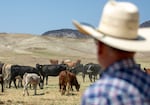
Lee Wright IV looks over his cattle, sheltering from the Durkee fire in his feedlot, to the burned hills that once made up his grazing lands near Vale, Ore., July 31, 2024. Wright lost nearly twenty thousand acres of grazing land to the fire-- meaning he will likely have to lease other pastures for his herd, or sell those he can't afford to feed.
Anna Lueck / OPB
Some 40 miles out from the Idaho border, Lee Wright IV is just about done unloading a truck of hay at his Eastern Oregon feedlot. He hops off his tractor and walks over to a barn to get some shade and looks to the distance — to black mountains usually covered with grass and peppered with sage brush.
“I’ve been looking at black ground for so long now that it almost looks normal. I mean, it kind of makes you have a sick feeling in your stomach,” he says. “It’s not supposed to burn the whole country. We’re supposed to have little fires.”
The Durkee Fire went through almost all 20,000 acres of his range grounds. He was forced to trail some 600 cattle on horseback off the mountains and then load them on trailers headed back to his feedlot.
Keeping his cattle fed will be more expensive now. He plans to send the calves to a separate feedlot to relieve some of the stress on the nursing cows, and he already has some pastures lined up for his cattle. But that won’t be enough.
“I’ll have to sell some cows,” he says.” I won’t have enough grass next year to keep them all.”
Rangelands could take a while to recover

(Left to right) In these supplied photos dated July 19, 2024, ranchers work to battle the fire on the ranch, and a small group of cows are surrounded by land charred in the Durkee fire.
Courtesy of Kyla Wright
Native grasses might come back on their own, but it might also take a while before they do.
“I mean it’s black, and that takes quite a bit of time depending on what the seed bank was and how much moisture we get over winter and in the spring,” said Whitney Rohner, the executive director of the Baker County Soil and Water Conservation District. “It’s too early to tell just exactly what the range of land loss is right now.”
Rohner said it’s likely her office, along with federal and state partners, will have to intervene and re-seed some areas before other invasive grasses take root. But that takes a lot of resources and funding. Rohner said because so much land has burned, she’s not confident they will be able to rehabilitate all of it.

Whitney Rohner, executive director of the Baker County Soil and Water Conservation District.
Anna Lueck / OPB
“It’s not going to be possible for us to go in and re-seed absolutely everything. It just won’t be,” she said.
As for federal range grounds, it could take up to two years until the Bureau of Land Management determines the land can be grazed again, according to Larisa Bogardus, a public affairs specialist for the BLM’s Vale district bureau office.
“Areas burned by wildland fire, including those subsequently rehabilitated, will be rested from grazing one full year and through a second growing season at a minimum, or until monitoring data or professional judgment indicate that health and vigor of desired vegetation has recovered to levels adequate to support and protect upland function,” Bogardus told OPB in a statement.
Several Oregon lawmakers have already reached out to the U.S. Department of Agriculture for aid. Gov. Tina Kotek wrote to USDA Secretary Tom Vilsack on July 31 asking the agency to declare a disaster for several counties fighting wildfires, which would make ranchers and farmers eligible for federal emergency loans.
“Our communities look to us for leadership and action in times of need,” Kotek wrote. “The timely review and approval of our request will provide critical support to the affected farmers and ranchers, helping them recover and rebuild.”
Kotek also asked Vilsack to coordinate with the U.S. Forest Service to allow more flexibility around where and when ranchers can graze their cattle while the rangelands recover.
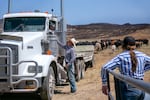
Lee Wright, center, shakes a neighbor's hand after they drop off a hay donation, as his daughter Kyla watches, at the Wright feedlot by Vale, Ore., July 31, 2024. The Wrights had a small stockpile of hay, but have also received donations from several neighbors after losing 20,000 acres of grazing land to the Durkee fire.
Anna Lueck / OPB
“This may include flexibility in grazing schedules, modifications to grazing permit conditions, and the use of alternative lands for immediate grazing needs,” Kotek wrote. “Oregon’s livestock ranchers are stewards of the lands, and temporary grazing permits may provide relief and support as the landscape recovers from the devastating fires.”
A handful of farm groups, including the Oregon Farm Bureau, have already put together relief funds for ranchers, and other farmers from across the state have even started to truck in bales of hay for ranchers left with nothing.
“It’s been really incredible to see people that maybe don’t even know whose ground they’re on, helping move livestock and hauling water and supplies for volunteers,” she said.
Lee Wright agrees. “And it’s not only ranchers, the farmers — I mean we’re all hand in hand,” he says. “They grow the feed that we feed the cows and we grow the meat that sits on the farmer’s table at night and we’re kind of helping one another out.”
But wildfire season is not over yet. Other fires still burn across Eastern Oregon, and there could be more hot, dry days ahead.


